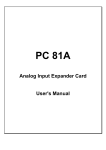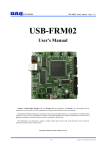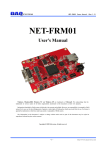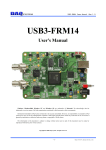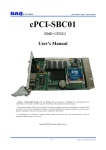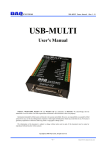Download USB-LT User`s Manual
Transcript
USB-LT(Light) Users Manual (Rev 1.1) USB-LT User’s Manual Windows, Windows2000, Windows NT and Windows XP are trademarks of Microsoft. We acknowledge that the trademarks or service names of all other organizations mentioned in this document as their own property. Information furnished by DAQ system is believed to be accurate and reliable. However, no responsibility is assumed by DAQ system for its use, nor for any infringements of patents or other rights of third parties which may result from its use. No license is granted by implication or otherwise under any patent or copyrights of DAQ system. The information in this document is subject to change without notice and no part of this document may be copied or reproduced without the prior written consent. Copyrights 2005 DAQ system, All rights reserved. -1- http://www.daqsystem.com USB-LT(Light) Users Manual (Rev 1.1) Contents 1. Introduction 2. Installation 3.1 Confirm Product Contents 3.2 Installation 3. USB-LT Board 3.1 USB-LT Concept 3.2 Memory Map 3.3 Connector Pin-out 3.4 Sample Program 4. Test 4.1 Input Test 4.2 Output Test 5. Specification 5.1 General Specification 5.2 Physical Dimension Appendix A.1 Schematic A.2 Application Circuit (Isolation Input/Output) A.3 API Reference -2- http://www.daqsystem.com USB-LT(Light) Users Manual (Rev 1.1) 1. Introduction The total control takes charge of the Micro controller in case of USB-LT as like Figure 1-1. To connection USB and I/O take charge of the 8Bit Micro Controller, the command set equally use the 8051 command set. Each I/O port can use wanted purpose whether or not set up input or output to user. USB-LT I/O Port1 USB Interface USB Low Speed Device 2.0 Specification SIE 16Byte USB FIFO Two 16Bit Timer/Counter I/O Port4 8Bit CPU 8051 Compatible Program Instruction I/O Port5 I/O Port6 I/O Input /Output ROM(OTP) 16KByte RAM 256Byte I/O Port7 [Figure 1-1. USB-LT Block Diagram] Internal program memory is taken possession of programmed firmware, program memory is OTP (One Time Programmable) type. [Main Function] • USB 2.0 Specification, Low speed(1.5Mbps) • 16K Program memory (EPROM-OTP), 256B RAM • 32 General Purpose I/O • 8051 Compatible command set • USB HID without device writing • Easy USB Application product development • Power Supply through USB (Max 500mA) • Easy API to develop application program -3- http://www.daqsystem.com USB-LT(Light) Users Manual (Rev 1.1) • To development various application program with PC(ex : USB Jog & Shuttle, USB Remote control, USB Key-pad, USB Program etc..) [Application Filed] - USB Key-pad, Clock, Electronic display, Jog & Shuttle, Voltage meter - USB Data acquisition (Temperature/Humidity/Voltage/ Current Measurement) - USB I/O Control - USB Remote Control (Electric product control through PC) - USB Programmer (Serial Flash, ROM, EEPROM, etc..) -4- http://www.daqsystem.com USB-LT(Light) Users Manual (Rev 1.1) 2. Installation You confirm whether or not the packing contents are in good order before installation. 2.1 Confirm Product Contents [Figure 2-1. USB-LT Product Contents] Product Contents 1. USB-LT 2. USB (A-B) Cable 3. CD (Manual/API/Sample Source etc..) 2.2 Installation For USB-LT board installation to PC is as follows. There isn’t a Jumper to especially to set up for board installation in case of USB boards as it is Plug & Play devices. Also, there is no need to install of device driver because of HID (Human Interface Device) connection in case of USB-LT. (1) First, open the box and connect to PC through USB cable. (2) The opposite side of USB cable connects to USB-LT board. (3) If cable connection succeeds, LED light on for indication of board supply. (4) It confirms a driver normally installation in the following ways. -5- http://www.daqsystem.com USB-LT(Light) Users Manual (Rev 1.1) Do the following steps to show up the “Device Manager” window. [My Computer -> Properties -> Hardware -> Device Manager -> Human Interface Devices -> “HID-compliant device” [Figure 2-2. “System Properties” window] [Figure 2-3. System Properties window] -6- http://www.daqsystem.com USB-LT(Light) Users Manual (Rev 1.1) [Figure 2-4. Device Manager Window] -7- http://www.daqsystem.com USB-LT(Light) Users Manual (Rev 1.1) 3. USB-LT Board In this chapter, the primary functions of the board are described briefly. For more information, refer to the device specification. 3.1 USB-LT Concept USB-LT Board 28 27 26 25 24 23 22 21 20 19 18 17 16 15 SW1 USB B type Connector MICOM LED1 LED2 1 2 3 4 5 6 7 8 9 10 11 12 13 14 [Figure 3-1. USB-LT Out-side View] USB-LT can easily use the functions of I/O, so simple circuit can be composed to universal board. (1) USB B type Connector The USB-LT board connects to the PC through the USB A-B cable. The power supply and data gives and takes through this cable. (2) LED1 It confirms supply power to board. (3) MICOM It is 8bit Micro Controller which has the 8051 compatible command set. It takes charge of I/O and USB data communication. (4) PIN 1-28 It supplies the power and I/O to external. The PC +5V power is supplied outside through the USB cable. If external board has special power, the power between each other shall not be connected. -8- http://www.daqsystem.com USB-LT(Light) Users Manual (Rev 1.1) (5) SW1 Board reset button. (6) LED2 It can confirm whether or not there is a stability of a board. 3.2 Memory Map The board has a program memory and data memory as like general 8051. The program memory area is OTP type. User can not reprogram it because of the board was programmed to supply in case of shipment. So, if you want special program, (You need more speedy response and private application) please contact to DAQ system. 16KByte Program Memory 256Byte Data Memory [Figure 3-2. Memory Map] -9- http://www.daqsystem.com USB-LT(Light) Users Manual (Rev 1.1) 3.3 Connector Pin-out The board has two connectors. There are the USB-B connector for USB communication, the PIN-OUT of DIP IC type connector for external I/O and power. And There is several test points. USB-B type is a connector for High speed USB connection. Figure 3-3 and Table 3-1 shows the connector and its pin description. 2 1 USB B type Connector 3 4 [Figure 3-3. USB-B connector (USB-B type Front View)] [Table 3-1. USB-B Connector] Pin Signal Name Description 1 VCC 2 D- USB signal Minus(Negative) 3 D+ USB signal Plus(Positive) 4 GND Remark USB power +5V USB power GND USB-LT Board 28 27 26 25 24 23 22 21 20 19 18 17 16 15 SW1 USB B type Connector MICOM LED1 LED2 1 2 3 4 5 6 7 8 9 10 11 12 13 14 [Figure 3-4. PIN-OUT of DIP IC type (1..28)] -10- http://www.daqsystem.com USB-LT(Light) Users Manual (Rev 1.1) [Table 3-2. DIP IC PIN-OUT] No. Name Description Remark 1 P53 Bit 3 of Port 5 2 P52 Bit 2 of Port 5 3 P51 Bit 2 of Port 5 4 P50 Bit 0 of Port 5 5 P47 Bit 7 of Port 4 6 P46 Bit 6 of Port 4 7 P45 Bit 5 of Port 4 8 P44 Bit 4 of Port 4 9 P43 Bit 3 of Port 4 10 P42 Bit 2 of Port 4 11 P41 Bit 1 of Port 4 12 P40 Bit 0 of Port 4 13 P66 Bit 6 of Port 6 14 GND Power Ground, Supply power to external board. 15 P65 Bit 6 of Port 6 16 P17 Bit 7 of Port 1 3 17 P16 Bit 6 of Port 1 3 18 P15 Bit 5 of Port 1 3 19 P14 Bit 4 of Port 1 3 20 P13 Bit 3 of Port 1 3 21 P12 Bit 2 of Port 1 3 22 P71 Bit 1 of Port 7 23 P70 Bit 0 of Port 7 24 P57 Bit 7 of Port 5 25 P56 Bit 6 of Port 5 26 P55 Bit 5 of Port 5 27 P54 Bit 4 of Port 5 28 +5V USB power +5V, Supply power to external board. 2 -11- http://www.daqsystem.com USB-LT(Light) Users Manual (Rev 1.1) [Table 3-3. Test Point PIN-OUT] Name Description Remark TP0 Bit 0 of Port 6 2 TP1 Bit 1 of Port 6 2 TP2 Bit 2 of Port 6 2 TP3 Bit 3 of Port 6 2 TP4 Bit 4 of Port 6 2 (Remark) 1. A bit 7 of Port6 is connected to LED2, this bit is set up to output. If output is “Low” and “ 0V”, LED2 light on. 2. There is a circuit to limit current to internal in case of Port6. If LED light on, there is no need to limit special current resistor to external. 3. The port1 has same specification of port1 of standard 8051. In other words, it can set up weak pullup only. -12- http://www.daqsystem.com USB-LT(Light) Users Manual (Rev 1.1) 3.4 Sample program A sample program is provided to make the user get familiar with the board operation. There is no installation of special driver because USB HID device is used to driver with supported Windows system. The sample program has two programs. One is a program to decision whether the board is strange action or not. The other is a program to set up I/O of each port and to control output. [Figure 3-5. Sample Program 1] -13- http://www.daqsystem.com USB-LT(Light) Users Manual (Rev 1.1) [Figure 3-6. Sample Program 2] To run the sample application program, you need to use API (Application Programming Interface), which is a form of client DLL. To compile the sample source to make its executable file, you have to use Import Library files and Header files. You can find them in the CDROM. -14- http://www.daqsystem.com USB-LT(Light) Users Manual (Rev 1.1) 4. Test 4.1 Input Test This chapter is for test to learn how to operate a board and check the abnormality of a board. The test performs it at the PC which a USB-LT board was installed as it use a program of “sample1.exe” in an EXE folder of CDROM. The execution file and source file of sample1 and sample2 is in App and App0 folder of CDROM. The execution file use a test, a user modifies a necessary a sample source file that provided it usable. [Figure 4-1. “Sample1.exe” Window] In the left LED is on at the above pictures, in the right LED is off. If an input of bit1 of port6 is “1’, LED is on, on the contrary to this, LED is off. In other words, If TP0 connect to VCC (+5V), LED is on. IF TP0 connect to GND, LED is off. At this time, the bit1 of port6 is used to set up by input at the above programs. -15- http://www.daqsystem.com USB-LT(Light) Users Manual (Rev 1.1) 4.2 Output test (1) You can test of output function through LED is on/off in a board at below pictures. [Figure 4-2. LED on/off display] In the top LED is off, in the bottom LED is on. If an output of bit7 of port6 is “0’, LED is on, on the contrary to this, LED is off. User can test to press “ON/OFF” button at the Sample1 programs. -16- http://www.daqsystem.com USB-LT(Light) Users Manual (Rev 1.1) 5. Specification 5.1 General Specification Specification General Interface Functions • USB 2.0 Specification • Low Speed Device 1.5Mbps • USB HID Device • 8051 Compatible Inst ruction Set, 4 Clock per Cycle • 16K EPROM, 256Byte RAM, • USB Powered through USB-B Connector, Max 500mA • +5V Single Power operation • 32 General Purpose I/O • 28pin DIP-IC form factor. • Two 16bit Timer/Counter • User configurable(Schmitt trigger Input/ N-ch open drain Output ) • Full-up option for each I/O. • 1 Control En dpoint, 2 Dat a Endpoints • 30 external interrupt source I/O Software Supported OS Windows 2000/XP API Custom Software Design Interface with Application through client DLL If user want special program t o have special function, user can inquiry t o modify Firmware. -17- http://www.daqsystem.com USB-LT(Light) Users Manual (Rev 1.1) 5.2 Physical Dimension 66 19 < Top View > 10.7 10.5 7 2.54 < Right Side View > [Figure 5.1 Physical Dimension Diagram] -18- http://www.daqsystem.com USB-LT(Light) Users Manual (Rev 1.1) Appendix A.1 Schematic -19- http://www.daqsystem.com USB-LT(Light) Users Manual (Rev 1.1) A.2 Application Circuit (Isolation Input/Output) It is used in the automations that used PC in case of USB-LT in order to simply input/output that it used the established serial (RS232), parallel (printer) ports. The advantage of USB-LT has no program confliction because of using exclusive USB source, on the other hand, RS232 and printer ports have a confliction between programs because of using common source. Also, control Input/output is possible as provide 31 I/O. If it exchange an input and output between different equipment like factory automations etc., it use a photo-coupler isolation in order to not to affect with mutual interference and influence at the below pictures. External Power Board Power R External Device IN < Photo-coupler Input Circuit> External Power Board Power R External Device OUTN <Photo-coupler Output Circuit> A register value at the above pictures can use properly selection which it fit to the external power. The industry power mainly uses 5V, 12V, 24V, 48V. -20- http://www.daqsystem.com USB-LT(Light) Users Manual (Rev 1.1) A.3 API Board Level API Functions Overview int InitBoard(void) int PortConfigure(WORD P4, WORD P5, WORD P6, WORD P7, WORD P1) int PortRead(BYTE *P4, BYTE *P5, BYTE *P6, BYTE *P7, BYTE *P1) int PortWrite(BYTE P4, BYTE P5, BYTE P6, BYTE P7, BYTE P1) InitBoard int InitBoard(void) It initializes USB-LT board. After power up, before using the board initialize first. Parameters: None Return Value: If the initialization fails, it returns “0”. If the initialization succeeds, it returns “1”. PortConfigure int PortConfigure(WORD P4, WORD P5, WORD P6, WORD P7, WORD P1) It decides whether or not to use input or output each port. Parameters: It decides input/output by each bit values of P4, P5, P6, P7, P1. The below pictures is sample of P4 value. -21- http://www.daqsystem.com USB-LT(Light) Users Manual (Rev 1.1) Bit Position 15 14 13 11 12 10 9 8 7 6 5 4 3 2 1 0 Port4.7 15/14 0 0 Schmitt trigger input 0 1 Schmitt trigger input with pull-up 1 0 N-ch open drain output 1 1 N-ch open drain output with pull-up Port4.6 13/12 0 0 Schmitt trigger input 0 1 Schmitt trigger input with pull-up 1 0 N-ch open drain output 1 1 N-ch open drain output with pull-up Port4.1 3/2 0 0 Schmitt trigger input 0 1 Schmitt trigger input with pull-up 1 0 N-ch open drain output 1 1 N-ch open drain output with pull-up Port4.0 1/0 0 0 Schmitt trigger input 0 1 Schmitt trigger input with pull-up 1 0 N-ch open drain output 1 1 N-ch open drain output with pull-up P4, P5, P6, P7 is same type, There is only port0 and port1 in case of P7 for reference. So, a value of bit 0,1,2,3 is meaning. In case of P1 is as follows. -22- http://www.daqsystem.com USB-LT(Light) Users Manual (Rev 1.1) Bit Position 15 14 13 12 11 10 9 8 7 6 5 4 3 2 1 0 Port1.7 - Port1.0 7 -- 0 0 Pull-up disable 1 Pull-up enable A P1 is same handling standard Port1, don’t need to dedicate input/output, But it decide whether or not to stick an internal pull-up resister. It is meaning from bit0 to bit 7 of parameter P1, it is meaningless from bit15 to bit 8. Return Value: If the initialization fails, it returns “0”. If the initialization succeeds, it returns “1”. PortRead int PortRead(BYTE *P4, BYTE *P5, BYTE *P6, BYTE *P7, BYTE *P1) It returns current input state of each port. Parameters: None Return Value: If the initialization fails, it returns “0”. If the initialization succeeds, it returns “1”. PortWrite int PortWrite(BYTE P4, BYTE P5, BYTE P6, BYTE P7, BYTE P1) It outputs designated value of each port. Parameters: None Return Value: If the initialization fails, it returns “0”. If the initialization succeeds, it returns “1”. -23- http://www.daqsystem.com USB-LT(Light) Users Manual (Rev 1.1) Port1Write int Port1Write(BYTE act, BYTE pos) It outputs designated value of each bit of port1. 0 and1 of port1 are used to USB data lines, it cannot record an entire value. You shall perform separately a writing command each bit (except bit0 and bit1). Parameters: act: If it is ‘0’, it writes “0”. If the value isn’t ‘0’, it writes ‘1’. pos: It indicates a bit position(from 2 to 7). Last value is meaningless. Return Value: If the command function fails, it returns “0”. If the command function succeeds, it returns “1”. -24- http://www.daqsystem.com USB-LT(Light) Users Manual (Rev 1.1) References 1. USB 2.0 System Architecture -- Don Anderson, USB SIG (www.usb.org) 2. Universal Serial Bus Specification -- Compaq/Intel/Microsoft/NEC, MindShare Inc. (Addison Wesley) -25- http://www.daqsystem.com



























